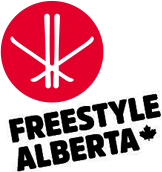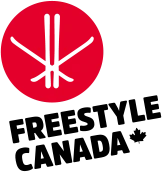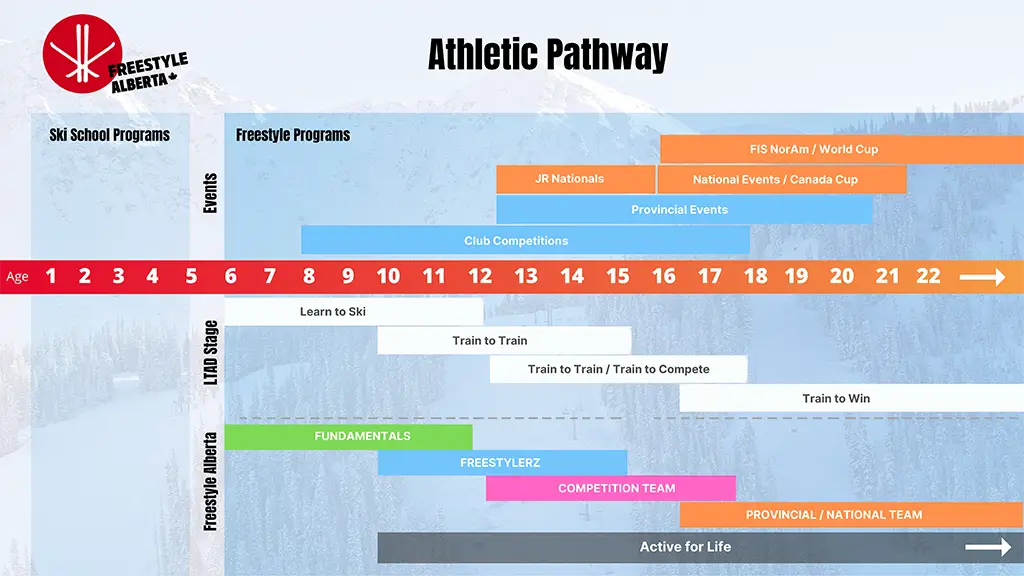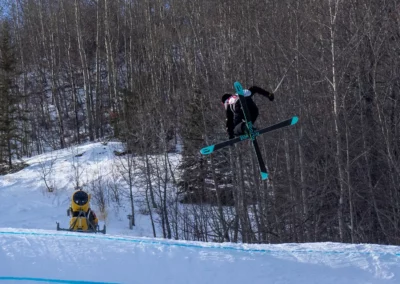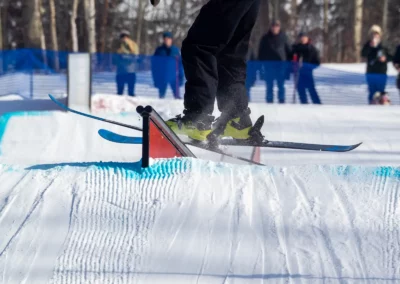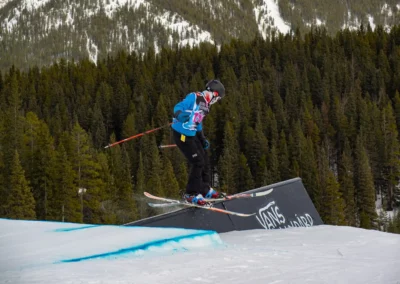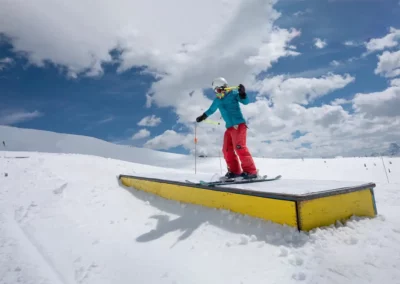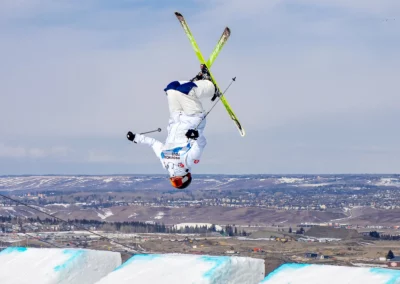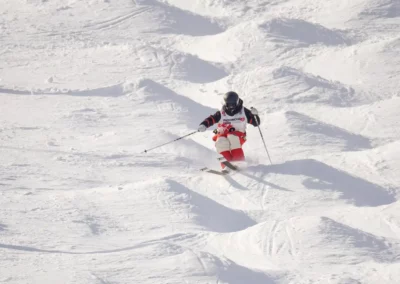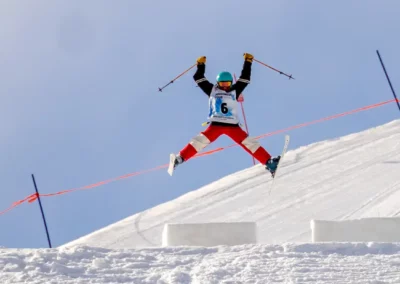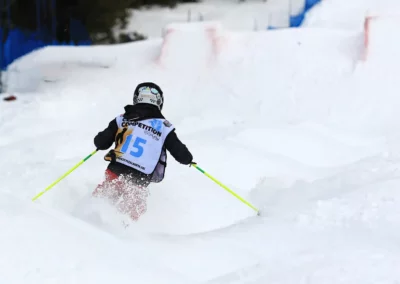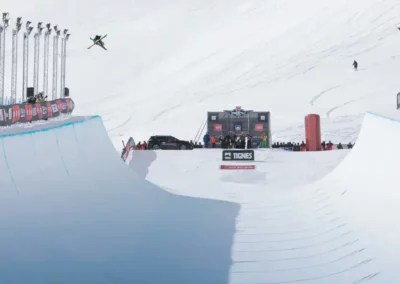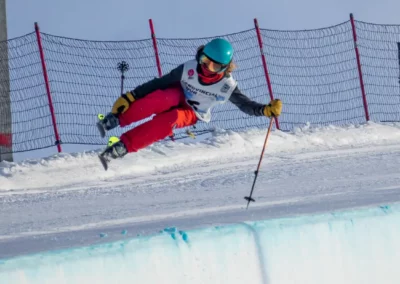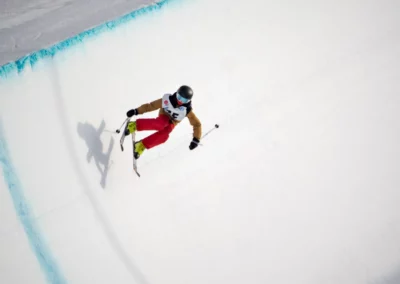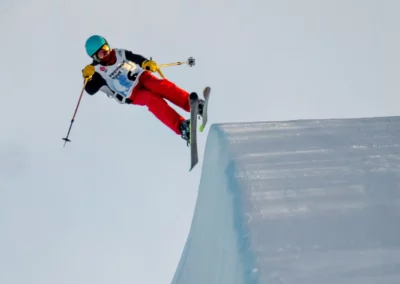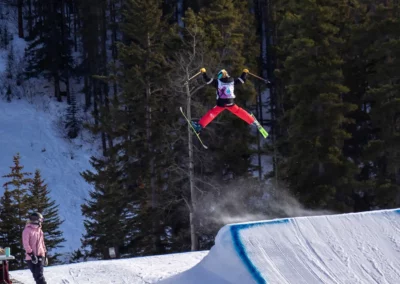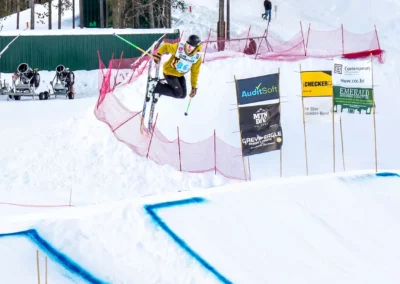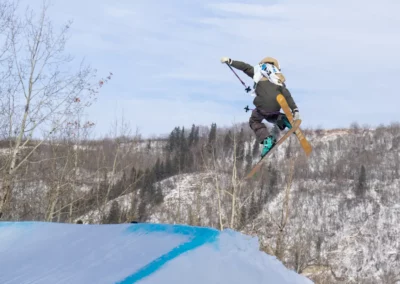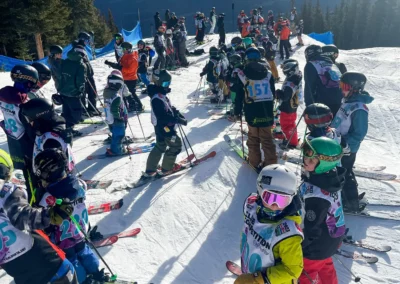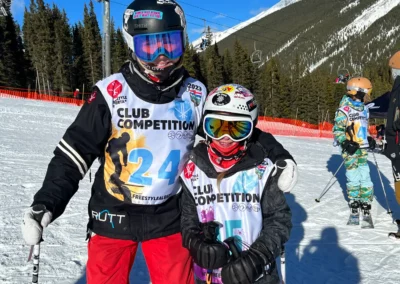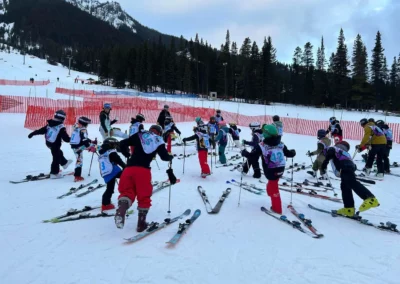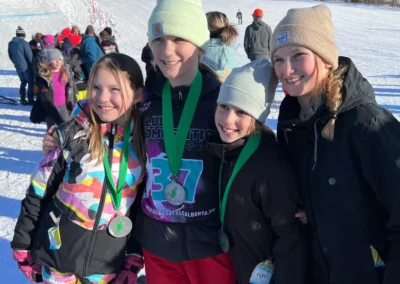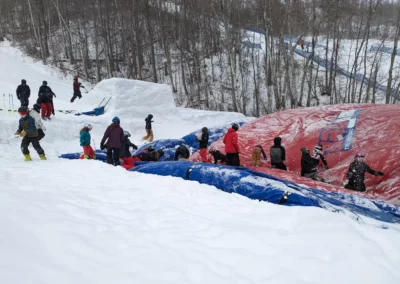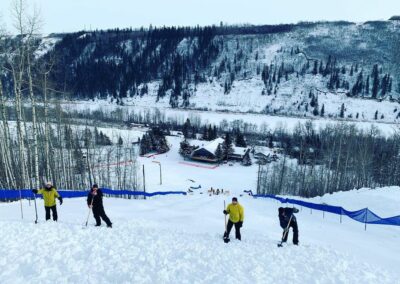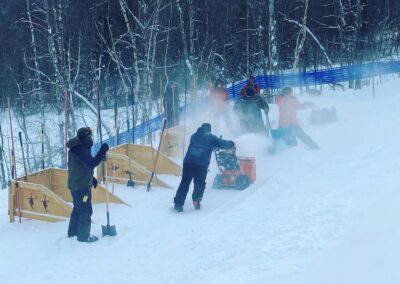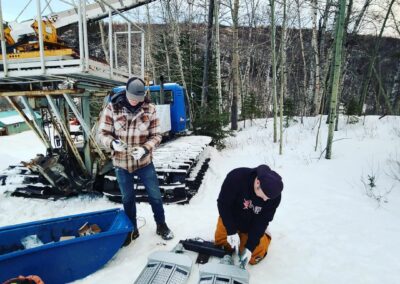About Freestyle
Freestyle Skiing Explained
Freestyle skiing is multidisciplinary with several events to train and compete in, including Slopestyle, Moguls, Dual Moguls, Halfpipe, & Big Air. Training can often last all year with options in the summer.
Our Philosophy
- Fun, safe, inclusive environment with process-driven coaching.
- Cross-training and balanced development.
- Personalized plans by developmental age.
Our ski club is dedicated to fostering passion, skill, and a lifelong love for skiing by empowering athletes through expert coaching, parental involvement, and an unwavering commitment to safety. We believe in creating a fun, inclusive, and supportive environment where athletes can thrive.
By encouraging intrinsic motivation, we help skiers find internal validation in their progress, focusing on the journey rather than just the results. Through the use of SMART goals and positive reinforcement, our “correct over detect” feedback method ensures that athletes grow into well-rounded, competitive skiers while enjoying the process every step of the way.
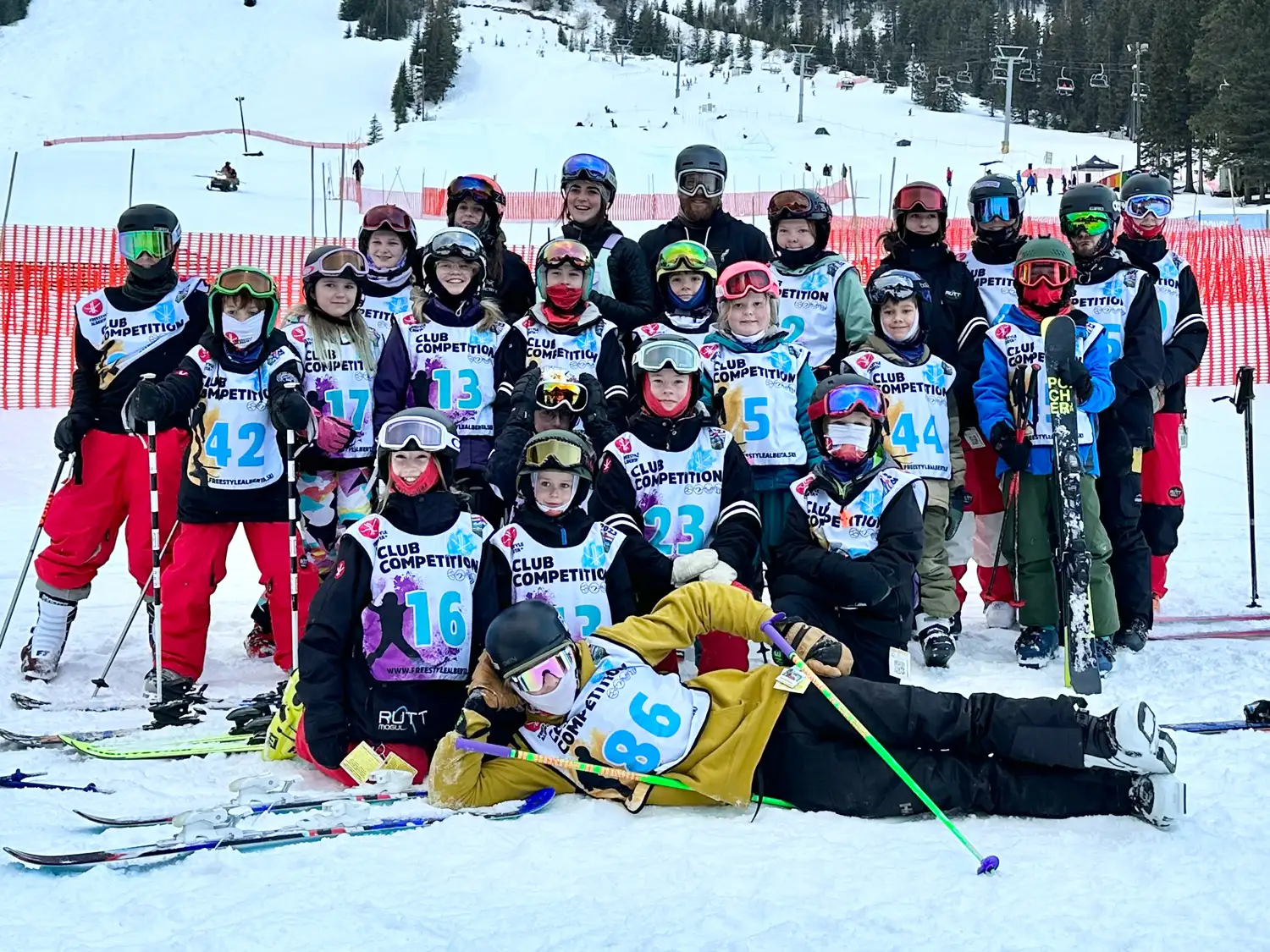
Freestyle Training
Freestyle skiing is a great crossover sport for athletes who enjoy gymnastics or climbing, and it’s one of the best activities kids in for winter.
Central Alberta Freestyle adheres to the Freestyle Alberta Athlete Pathway, striving to develop athletes who are prepared to compete at their next level. The program also emphasizes life-long fitness, skill development, and the cultivation of strong character.
We focus on the Learn to Ski*, Train To Train, & Train To Compete stages of the athlete pathway.
Equipment required
Specialized skis, boots, poles, helmet, goggles & body armour (as needed). Ask our coaches if you need to know which you need.
Training may include:
Training in freestyle skiing is multifaceted, incorporating a variety of activities to build comprehensive skills and maintain peak performance.
- Multiple training days each week
- Travel to alternate facilites for additional training and competitions
- On-snow training
- Airbag training
- Water Ramp Training
- Trampoline Training
- Yoga, running, climbing, & other cross training
- And, of course, lots of fun!
* Athletes must have basic ski skills to enter our program
Provincial Sport Organization:
National Sport Organization:
On-Snow Registration Opens
September 27 / 8 am!
Day(s)
:
Hour(s)
:
Minute(s)
:
Second(s)
Register for on-snow ski
season in 3 steps:
- Register with FreestyleCanada & FreestyleAlberta
- Download TeamSnap
- Purchase the required ski resort passes (consider buying early bird passes if possible).
You may want to talk to our coaches prior to registering to ensure the correct placement.
Freestyle Ski Disciplines
Slopestyle
Slopestyle athletes navigate a course filled with a variety of obstacles including rails, jumps, and other terrain park features — earning points for amplitude, originality, and the execution of quality of tricks. The discipline, which has its roots in action sports like skateboarding and BMX biking, has seamlessly transitioned r into the snow sports worlds of skiing and snowboarding.
Slopestyle is one of the most accessible categories, as nearly every ski resort has a terrain park where aspiring athletes can learn to jump, spin, grind, grab & flip.
Places we train:
Canyon Ski Resort
Winsport (Calgary)
Sunshine (Bow Valley)
Athletes are judged on:
Amplitude: How much air athletes get off the jumps
Degree of Difficulty: The degree of difficulty of the tricks they perform
Execution: How well the athletes perform their tricks
Overall: The whole package, including the athlete’s personal style. It includes the grabs and positions athletes add to the tricks to make them their own.
Moguls/Dual Moguls
Moguls are a course of bumps on a slope, with one or two jumps skiers must skillfully navigate while making sharp turns.
Competitive mogul skiing embodies challenge and excitement. Anyone who has tackled mogul knows how challenging they can be. Yet, skilled mogul skiers make it look effortless, display ncredible skill, athleticism, and courage, as they race straight down the fall line at lightning speeds, sometimes covering as many as four moguls per second!
Places we train:
Canyon Ski Resort
Panorama (Invermere Valley, BC)
Athletes are judged on:
There is a total possible score of 100 points. This metric varies per level (Club, Provincial etc).
20% goes to the airs (10% for each jump)
20% goes to speed
60% goes to the turns.
Halfpipe
Athletes compete by performing tricks while skiing down a half-pipe (or superpipe).
A halfpipe is a U-shaped ramp or course which has been purpose-built for sporting use. It’s typically used by skateboarders, BMX riders, snowboarders and skiers, who use the ramp to propel themselves into the air, where they’re able to pull tricks before landing again and continuing on to do the same on the other side of the pipe.
It’s great fun to watch. Each athlete drops into the halfpipe individually and completes a run down the length of the pipe, doing as many jumps and tricks as he or she can manage, to the best of their ability, and then whoever comes out the pipe at the bottom with the best score wins.
Places we train:
Athletes are judged on:
Amplitude: How much air athletes get off the jumps
Degree of Difficulty: The degree of difficulty of the tricks they perform
Execution: How well the athletes perform their tricks
Progression: The creativity and innovation of the run
Big Air
Big air is a sports discipline where the competitor skis down a hill or ramp and performs tricks after launching off very large jumps. In most versions, there is but one large jump, and therefore only one opportunity to perform a trick. It is an extreme version of slopestyle. Our competitions mostly include two large jumps leading to a rail park in one run vs a dedicated big air event.
Competitors perform complex tricks in the air, aiming to attain sizable height and distance as well, all while securing a clean landing. In the 2022 Winter Olympic Games the ski big air event was held for the first time in Olympic history!
Places we train:
Canyon Ski Resort
Winsport (Calgary)
Sunshine (Bow Valley)
Athletes are judged on:
Difficulty: The technical difficulty of tricks is assessed.
Execution: Control should be maintained throughout the whole trick, from take-off to landing. Grabs should be held properly and for as long as possible.
Amplitude: In big air, amplitude is not just about how “big” the athlete goes, but also landing the trick in the decided “sweet spot.”
Landing: Skiers must land with full control, with the trick already completed (i.e. no reverts, no hand drags).
Freestyle Competition
Competition Structure
Freestyle competitions are all structured the same: Athletes have warm-up and training in the morning or day prior, and then gather at the top of the run and wait for their turn to compete. In most cases, two runs are taken by each athlete to put forward the best time or run. Each discipline has its own criteria to score points or get the best time.
Viewing space for spectators varies from location to location, and spectators may be required to buy a pass and ski in to watch. Cow bells are encouraged!
Competition Levels & Teams
There are two primary levels Central Alberta Freestyle Athletes compete in: Club & Provincial events.
- Club competitions: U8 to U16. The first level, fun and growth are the focus and almost all athletes start here. A “Club” athlete can attend ONE “Provincial” event per year. Typically our Fundamentalz & Freestylerz are this level.
- Provincial Events: U12 to U20. A higher level of competition, with more training and higher expectations. Once you register for this level, you cannot revert down to Club level. Typically, our Freestylerz & Competition Development Team are at this level.
- Provincial Team: Higher level athletes may advance to the provincial team. Many Central Alberta Freestyle athletes have advanced to this team, and on to the Olympics, like Deidra Dionne. Athletes will be required to train much more, and travel to NorAm competitions, and Junior Nationals.
- National Team: The Olympic Dream awaits! Nationals, World Cups and the Olympics are competed in at this level.
Places we compete:
Canyon Ski Resort (Red Deer)
Winsport (Calgary)
Sunshine (Bow Valley)
Norquay (Bow Valley)
Castle Mountain (Crowsnest Pass)
Marmot Basin (Jasper)
Tawatinaw Valley (Westlock)
Volunteering
It’s about Community!
Freestyle is a complex sport to run and requires a lot to keep courses and facilities running for our kids. From the Olympics down to a snowy Wednesday night with U12s, volunteers drive this sport – and it would virtually cease to function without them. We LOVE our volunteers!
We need everyone on our team to help with many tasks, and many hands make light work. We need help with:
- Shoveling snow off the air bag
- Doing a “Chop” of the mogul landings – this needs to be done 1-2 times each practice. It softens the landings and reduces injuries.
- Set-up, take-down judging, people moving and event management at competitions
- Fundraising
